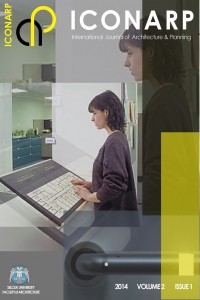Abstract
|
|
Abstract
In our country, disabled people encounter many .problems in integrating with the city and city life. The most important one is the "accessibility" in the physical space. Providing accessibility require disabled to move without being in need of any help, without any prevention and to participate in the life activities. It is seen in our country that the obstacle-free walkways for the disabled do not exist in the cities including the pedestrian areas, the legal arrangements with respect thereto are not yet able to achieve the required conditions in the physical environment, and the required sanctions and controls are not sufficient. Moreover, inability to present accurately the difference in the needs as based on the disability type is exposed in the problems that occur in the arrangements realized.The basic needs of "visually-impaired" people in the urban space, which constitutes the subject matter of the study can be listed as; safety, to understand where s/he is going, to know where s/he is and to obtain information about the surrounding. For the visually-impaired people to obtain such needs depends on their ability to move alone in the urban space. One of the most important issues in achieving this is "orientation". "Orientation" involves the process of determination of the person's own position and relation with the important objects around. It is known that the "accessibility" of a visually-impaired person is based on orientation and the arrangements in the physical environment in achieving this are very important.In this study, the purpose is to present the significance of "orientation" directed to increase the accessibility of the "visually-impaired" people in the urban space and as based on this, to discuss "the arrangements required to be realized in the physical environment”.
References
- Avrupa Birliği’nde Özürlülere Yönelik Yasal Düzenlemeler (2011).
- CFPSAA (Confédération Française pour la Promotion Sociale des Aveugles et Ambylopes).(2010). ”Les Besoins des Personnes déficientes visuelles /Accés a la Voirie et au Cadre Batie”.France.
- Guide Technique de L’Accesibilité des Espaces Publics de la Ville de Caen.(2010).
- Herkes için Ulaşılabilirliğin İyileştirilmesi Örnek Uygulama Rehberi.(2008) Özürlü ve Yaşlı Hizmetleri Genel Müdürlüğü,Ankara.
- Köseler,H.(2006). Görme Özürlüler İçin Baston Kullanımını Önemi ve Tarihçesi,Engelsiz Erişim Derneği.
- Köseler,H.(2006). Görme Özürlüler İçin Baston Kullanımını Önemi ve Tarihçesi’,
- Lynch,K.(1993).L’Image de La Cité, Bordas.
- Ministry of Social Affairs National Committee for the Disabled (2010)‘Accessibility for the Disabled. A Design FreeEnvironment’,http://www.un.org/esa/socdev/en able/designm/index.html (Accessed 10.October.2013)
- Özyürek M. (2008)‘GörmeEngelli Kişiler’<http://www.aof.anadolu.edu.tr/kitap/IOLTP/ 1267/unite09.pdf> (Accessed 13.October.2013).
- Pailhous,J(1970)’Analyse des touches complexes par les mouvements’no:70,Revues Critiques, <http://www.persee.fr >( Accessed 17.October.2013)
- Sağlık Örgütü .(2002).(WHO) Raporu
- Schmidt,E.&ManserJ.A.(2003).”Rues,Che- mins,Places”Directives”Voies piétonniers adaptés aux handicapées,Zurich. T.C.Başbakanlık Özürlüler İdaresi Başkanlığı,Ankara.
- TDK Güncel Türkçe Sözlük< http://www.tdk.gov.tr >(Accessed 10.October.2013)
- Thomas,R.(1999).”Cheminer L’Espace en Aveugle, Corps stigmatisé,Corps compétent,no:9,Alinéa.Zevi,B.(1976). “Apprendre a voir l’architecture,Ed.de Minuit,Paris. (Citat. Thomas R.1999)“Cheminer l’Espace en Aveugle, Corps stigmatisé Corps compétent”
- Zevi,B.(1976).’Apprendre a voir l’architecture’.Paris:ed.de Minuit.
- http://www.<engelsizerisim.com. (Accssed10.October.2013)
- http://www.persee.fr (Pailhous,j.1970.”Analyse des touches complexes par les mouvements”sayı:70,Revues Critiques).( Accessed 17.October.2013)
- http://www.aof.anadolu.edu.tr/kitap/IOLTP/1267/unite09.p df ( Özyürek M., Visually impaired people) (Accessed 13.October.2013
- http://www.aof.anadolu.edu.tr/kitap/IOLTP/1267/unite09.p df (Accessed 13.October.2013)
- http://www.altinokta.org.tr (about visually impaired people)(Accessed 17.October.2013
- http://www.tdk.gov.tr (TDK Current Turkish Dictionary)
- (Accessed 10.October.2013)
- http://www.un.org/esa/socdev/enable/designm/index.html (Accessibility for the Disabled A Design Manual for a Barrier 10.October.2013).
- Environment)(Accessed
- Remark: The images in the section, “The changes to be made in the physical environment so as to maintain orientation” were provided from the text prepared by CFPSAA. RESUME
Abstract
References
- Avrupa Birliği’nde Özürlülere Yönelik Yasal Düzenlemeler (2011).
- CFPSAA (Confédération Française pour la Promotion Sociale des Aveugles et Ambylopes).(2010). ”Les Besoins des Personnes déficientes visuelles /Accés a la Voirie et au Cadre Batie”.France.
- Guide Technique de L’Accesibilité des Espaces Publics de la Ville de Caen.(2010).
- Herkes için Ulaşılabilirliğin İyileştirilmesi Örnek Uygulama Rehberi.(2008) Özürlü ve Yaşlı Hizmetleri Genel Müdürlüğü,Ankara.
- Köseler,H.(2006). Görme Özürlüler İçin Baston Kullanımını Önemi ve Tarihçesi,Engelsiz Erişim Derneği.
- Köseler,H.(2006). Görme Özürlüler İçin Baston Kullanımını Önemi ve Tarihçesi’,
- Lynch,K.(1993).L’Image de La Cité, Bordas.
- Ministry of Social Affairs National Committee for the Disabled (2010)‘Accessibility for the Disabled. A Design FreeEnvironment’,http://www.un.org/esa/socdev/en able/designm/index.html (Accessed 10.October.2013)
- Özyürek M. (2008)‘GörmeEngelli Kişiler’<http://www.aof.anadolu.edu.tr/kitap/IOLTP/ 1267/unite09.pdf> (Accessed 13.October.2013).
- Pailhous,J(1970)’Analyse des touches complexes par les mouvements’no:70,Revues Critiques, <http://www.persee.fr >( Accessed 17.October.2013)
- Sağlık Örgütü .(2002).(WHO) Raporu
- Schmidt,E.&ManserJ.A.(2003).”Rues,Che- mins,Places”Directives”Voies piétonniers adaptés aux handicapées,Zurich. T.C.Başbakanlık Özürlüler İdaresi Başkanlığı,Ankara.
- TDK Güncel Türkçe Sözlük< http://www.tdk.gov.tr >(Accessed 10.October.2013)
- Thomas,R.(1999).”Cheminer L’Espace en Aveugle, Corps stigmatisé,Corps compétent,no:9,Alinéa.Zevi,B.(1976). “Apprendre a voir l’architecture,Ed.de Minuit,Paris. (Citat. Thomas R.1999)“Cheminer l’Espace en Aveugle, Corps stigmatisé Corps compétent”
- Zevi,B.(1976).’Apprendre a voir l’architecture’.Paris:ed.de Minuit.
- http://www.<engelsizerisim.com. (Accssed10.October.2013)
- http://www.persee.fr (Pailhous,j.1970.”Analyse des touches complexes par les mouvements”sayı:70,Revues Critiques).( Accessed 17.October.2013)
- http://www.aof.anadolu.edu.tr/kitap/IOLTP/1267/unite09.p df ( Özyürek M., Visually impaired people) (Accessed 13.October.2013
- http://www.aof.anadolu.edu.tr/kitap/IOLTP/1267/unite09.p df (Accessed 13.October.2013)
- http://www.altinokta.org.tr (about visually impaired people)(Accessed 17.October.2013
- http://www.tdk.gov.tr (TDK Current Turkish Dictionary)
- (Accessed 10.October.2013)
- http://www.un.org/esa/socdev/enable/designm/index.html (Accessibility for the Disabled A Design Manual for a Barrier 10.October.2013).
- Environment)(Accessed
- Remark: The images in the section, “The changes to be made in the physical environment so as to maintain orientation” were provided from the text prepared by CFPSAA. RESUME
Details
| Primary Language | English |
|---|---|
| Journal Section | Makaleler |
| Authors | |
| Publication Date | August 8, 2014 |
| Published in Issue | Year 2014 Volume: 2 Issue: 1 |


